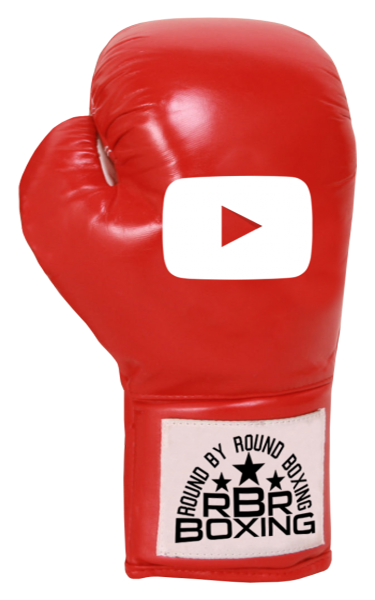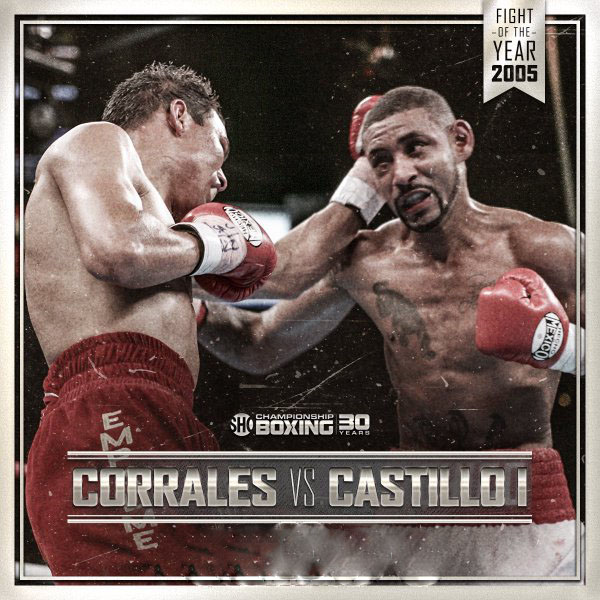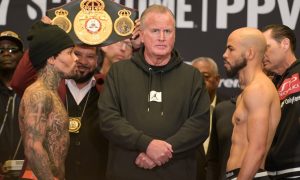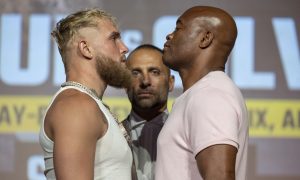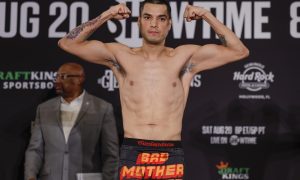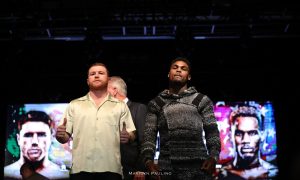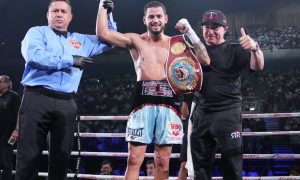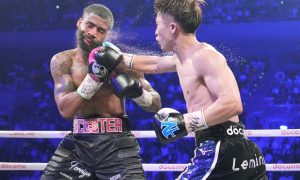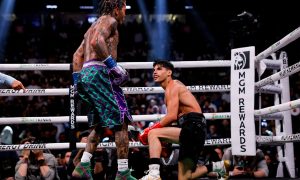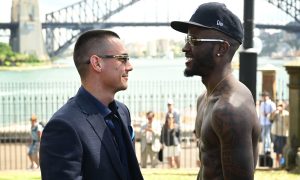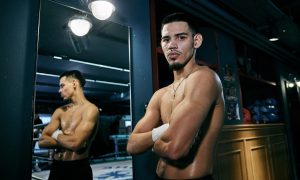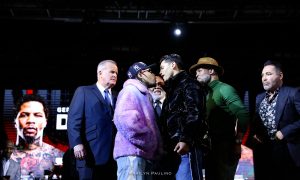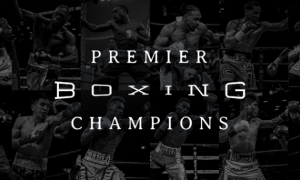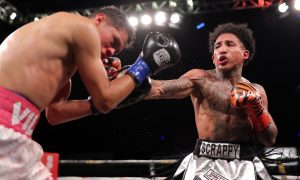In May 2005, I was a senior in high school, living in Honolulu, Hawaii. In Hawaii, at the Military Base, I lived in with my family, we didn’t have the premium cable channel, Showtime.
Luckily, my parents’ cable provider was offering the broadcast of that day’s upcoming Lightweight championship unification fight as a pseudo-PPV for $9.99.
Living on the east coast of the United States for more than 10 years now, one looks back and appreciates being able to watch championship boxing with a start time of 4:00 pm instead of 10:00 pm.
What I would witness that day was something that I would never forget. Nothing else has compared to it in watching any other sport or fight.
This holds true to this day.
After the 10th round of Diego Corrales vs. Jose Luis Castillo’s epic first clash, I remember running down the stairs like it was Christmas morning and leaping through the back door to reach my backyard and yelling at my father and his group of friends, “I just saw the best fight ever!”
On May 07, 2005, at the Mandalay Bay Resort & Casino in Las Vegas, Nevada, WBO Lightweight champion, Diego “Chico” Corrales (40-5, 33 KOs) met Mexico’s WBC Lightweight champion, Jose Luis Castillo (52-6-1, 46 KOs).
Both men were at the absolute apex of their careers heading into a collision course with one another. At this point, both Corrales and Castillo had experienced losses and setbacks, giving them a level of maturity entering a match of this magnitude.
Corrales was coming off some of the most significant victories of his career, having won a rematch over Cuban stylist Joel Casamayor for the WBO Super Featherweight title.
In the first half of his career, the power-punching California native had been the IBF Super Featherweight champion, having won the title from the now-famed trainer, Robert Garcia, in October 1999.
Corrales would make four defenses of his title, including two stoppage victories over Angel Manfredy and Derrick Gainer.
When he met Floyd Mayweather Jr. in January 2001, he fell victim to a virtuoso performance in arguably the most outstanding performance that Mayweather ever produced.
Corrales would return to the ring in January 2003 after a two-year hiatus with a stint in prison.
After defeating Casamayor, Corrales made his move up to Lightweight and defeated Brazilian power puncher Acelino Freitas into submission in 10 rounds in an often-forgotten classic.
The victory made Corrales a two-division champion and the holder of the WBO Lightweight title.
For the majority of the first half of his career, Castillo was known for being a sparring partner for the man considered to be the greatest fighter out of Mexico in Julio Cesar Chavez Sr.
That perception changed in 2002 when he became the closest man to have defeated Floyd Mayweather Jr. in a bout that is still debated to this day. Castillo lost a rematch against Mayweather, but would use his fights with the future Hall-of-Famer as a stepping-stone for further success.
Before facing Corrales, Castillo had three back-to-back impressive performances, defeating Juan Lazcano for the WBC Lightweight title, winning a split-decision over Joel Casamayor, and stopping Julio Diaz in 10 rounds.
Much like the first Marco Antonio Barrera vs. Erik Morales bout, Corrales-Castillo was for the hardcore boxing fan.
While most of the media was waiting in anticipation for Felix Trinidad’s Middleweight match with Ronald “Winky” Wright taking place the next week, Corrales-Castillo was at the forefront of those that swept through boxing message boards engaging in thorough discussions as to who would win.
There wasn’t a large audience in attendance for Corrales-Castillo at the Mandalay Bay, but in the audience, you could see other fighters such as Winky Wright, James Toney and Julio Cesar Chavez Sr. and Jr.
Expectations are usually the cause of disappointment. One’s imagination is often grander than reality. Boxing fans couldn’t have imagined a greater fight than Corrales-Castillo.
From the first round, it was clear that fans and those in attendance were witnessing something special. The fight was a college course for inside fighting, producing ebbs and flows and numerous momentum shifts.
Castillo found a home for uppercuts and body shots in each round and at one point, landed almost five uppercuts in a row.
Corrales was more successful when he threw punches in combination, and his right hand proved to be the one punch that could hurt the iron-chinned Castillo.
Looking back at the fight 15 years later, it was Corrales that seemed to lose a little piece of himself in each round. The amount of punishment sustained by both fighters was tremendous, but Corrales, in particular, was hit with so many flush shots that he took the brunt of the punishment.
Each round seemed to ratchet up in intensity until it reached its crescendo in the 10th round.
What makes the 10th round so significant is that it followed two rounds that could have been round of the year contenders.
Castillo would drop Corrales two-times in the 10th, and the fight seemed on the verge of ending.
It wouldn’t be boxing without controversy, and Corrales after each knockdown spit out his mouthpiece, leading referee Tony Weeks to deduct a point away from the California native.
It’s debatable how much these extra seconds helped Corrales; however, at that moment, it seemed that the ending of the fight was a foregone conclusion.
With words of motivation from his trainer Joe Goossen, Corrales was able to hurt Castillo when he came in for the kill, putting the crowd in a frenzy.
Corrales backed Castillo against the ropes, unloading a barrage of punches on the Mexican. Once Castillo’s hands began to drop, leaving him defenseless, referee Tony Weeks stepped in, putting a halt to the bout at the 2:06 mark of the 10th round.
The ending was controversial and electrifying. It was boxing at its best.
There are times when art imitates life, and with boxing being the highest form of art in sports, it’s unfortunate how the story of Corrales ended.
Corrales left everything in the ring against Castillo.
Two years to the day of his bout with Castillo on May 7, 2007, Corrales would pass away from injuries sustained in a motorcycle accident. He was only 29 years old.
Remarkably, Castillo would fight 20-more times following his fight with Corrales, including winning a rematch with Corrales via fourth-round knockout in October 2005.
However, he would never again reach the heights of where he stood before and during his first bout with Corrales.
To this day, there are longtime boxing writers who will still hold Corrales-Castillo as the best fight they have ever seen and covered.
The fight didn’t have the glitz and glamour of Floyd Mayweather vs. Manny Pacquiao, but it didn’t need that. It was a fight for boxing fans and those who have always watched the sport no matter its status among the mainstream media.
In the post-fight interview with Showtime’s Jim Gray, he would ask Corrales, “How would you describe this fight?”
“An honor,” responded Corrales.
The honor was ours. Thank you, Diego Corrales and Jose Luis Castillo, for providing a night of boxing that we will never forget.



